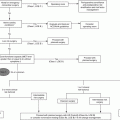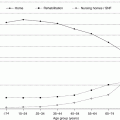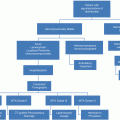Jay A. Yelon and Fred A. Luchette (eds.)Geriatric Trauma and Critical Care201410.1007/978-1-4614-8501-8_31
© Springer Science+Business Media New York 2014
31. Pulmonary Critical Care and Mechanical Ventilation
(1)
Department of Surgery, Virginia Commonwealth University, 980454, Richmond, VA 23298, USA
(2)
Department of Surgery, VCU Medical Center, 1200 East Broad Street, 15th fl. East, 980454, Richmond, VA 23298, USA
Abstract
Age-related diminution in function is felt the earliest in the respiratory system. Additionally, injury to and the reserve of the system has a disproportionately high impact on outcomes after trauma, especially in the elderly. Principals of management of the respiratory system, whether injured or not, relate to preventing alveolar collapse and maximizing gas exchange. Detecting deterioration and/or infection early with aggressive therapy forms the other pillars of management. If mechanical ventilation is required, utilizing lung protective strategies will optimize outcomes.
Aging has a negative impact on all organ systems in the body. Age-related diminution in physiology is felt on the respiratory system the earliest [1], and trauma to the chest has a disproportionate influence on outcomes following injury at all ages [2]. In addition to this direct impact chest trauma has on outcomes, even in the absence of direct chest injury, adequate oxygenation is critical to cellular homeostasis of all injured tissues/organs with the injured brain being at greatest risk of even brief periods of hypoxemia during the immediate post-injury period. For these reasons adequate pulmonary care following injury is critically important not only from the respiratory standpoint but also for overall recovery.
Age-Related Changes to Respiratory Physiology
While this subject is addressed in detail in other chapters, a brief review here is important to fully understand the basis of pulmonary care in the elderly especially following injury. The respiratory system consists of two fundamental elements: (1) a gas exchange mechanism in the lung that leads to inspired oxygen being transferred from the alveolus into the blood and carbon dioxide being transferred in the opposite direction and (2) the rib cage, respiratory muscles, and neural mechanisms that govern the act of breathing including the brain stem that responds to levels of oxygen and carbon dioxide in the blood [3]. Both elements of the respiratory system change with age in a manner that reduces reserve and our ability to increase the delivery of oxygen to the tissues following injury. In the lung while the total lung volume remains relatively constant, there is a decrease in vital capacity primarily caused by an increase in residual volume [4]. This directly limits the degree to which minute ventilation can be increased to facilitate greater oxygen delivery and removal of carbon dioxide. At the same time the closing volume increases, so even minor chest trauma leads to alveolar collapse and increased shunting resulting in a ventilation-perfusion (V/Q) mismatch [5]. In the chest wall, respiratory muscles participate in the overall decline in muscle mass with aging, limiting the ability to take deep breaths and effectively clear the airways of secretions [6]. Also the sensitivity of the brain stem to hypoxemia and hypercarbia is diminished leading to decreased respiratory drive. In addition to these age-related physiological changes, older patients may also have pulmonary comorbidities that further diminish respiratory function. Finally, all narcotic analgesics used for pain control, to a lesser or greater degree, diminish respiratory drive [7]. In summary, there is less drive, diminished strength, and poorer gas exchange setting the stage for respiratory failure.
Principles of Pulmonary Care in the Elderly
Certain principles apply to any elderly patient admitted to the hospital for any reason but are especially pertinent after injury. These are:
1.
Optimizing gas exchange
2.
Preventing aspiration
3.
Prevention of pulmonary infections
4.
Early detection of deterioration
5.
Early detection and prompt therapy of pulmonary infection
6.
Assistance with ventilation if required:
(a)
Noninvasive ventilation
(b)
Endotracheal intubation and assisted ventilation
7.
Liberation from mechanical ventilation and extubation
8.
Role of tracheostomy
9.
Ethical considerations and end of life care
Optimizing Gas Exchange
Gas exchange in the lung is dependent upon ventilation of the alveolus and perfusion of the ventilated alveolus or V/Q matching. Over time, there is an age-related decrease in the partial pressure of oxygen in arterial blood (PaO2) at the rate of 4 mmHg per decade without any change in the partial pressure of alveolar oxygen (PAO2) or partial pressure of arterial carbon dioxide (PaCO2) [8]. This is due to decreased efficiency of gas exchange across the respiratory membrane caused by increased thickness and reduced surface area, decreasing from nearly 75 m2 at age 20–60 m2 by age 70 [9].
Simple measures that maintain V/Q matching to ensure adequate V/Q matching include:
1.
Preventing atelectasis
(a)
Raising the head of the bed to 30°: Semirecumbent position is the preferred positioning adopted by the Institute for Healthcare Improvement in their ventilator bundle [10, 11]. Since patients in the supine position have lower spontaneous tidal volumes on pressure support ventilation than those in an upright position, it has been assumed that a semirecumbent position may facilitate ventilatory efforts [11, 12].
(b)
Incentive spirometry: A normal alveolar sac measures 0.3 mm in diameter. During normal breathing the alveolar sac inflates and then deflates, but does not completely collapse. The inflation and deflation stimulates surfactant production, a key to maintaining adequate compliance. Complete collapse of the alveolus leads to alveolar damage (see atelectrauma below) and reduces surfactant production thus making re-expansion difficult. Incentive spirometers, or sustained maximal inspiration devices, encourage deep breathing by augmenting pulmonary ventilation through the re-expansion, or recruitment of alveoli [13]. The routine use of incentive spirometers has been shown to be effective in reducing pulmonary complications [14–16].
2.
Providing adequate analgesia while minimizing sedation: Poor pain control may result in respiratory splinting and contribute to diminished inspiratory effort, while parenteral administration of narcotics depresses the cough reflex and may be sedating and limit the patient’s ability to clear airway secretions. These indirect effects on pulmonary function commonly lead to atelectasis and V/Q mismatch. A multimodal approach to analgesia consisting of epidural pain control, local analgesic delivery (i.e., topical lidocaine patches), and local nerve blocks is effective at minimizing narcotic use [17].
3.
Encouraging pulmonary toilet: Pulmonary toilet (or hygiene) refers to a set of therapies that facilitate clearance of secretions from the airways. Nasotracheal or endotracheal suctioning, chest physiotherapy and percussion, and prone positioning are widely accepted adjuncts to facilitate the removal of secretions from the tracheobronchial tree and prevent atelectasis [18, 19].
Preventing Aspiration
Aspiration is a common cause of respiratory failure among the elderly and occurs when oropharyngeal and/or gastric contents that may carry pathogens enter the airway. Chemical aspiration of gastric content results in a sterile chemical pneumonitis that damages type I pneumocytes impeding gas exchange, reduces surfactant production which results in alveolar collapse, and makes the patient prone to the development of microbial pneumonia – usually bacterial but sometimes viral or fungal. Risk factors contributing to aspiration include the positioning of the head of the bed <30°, presence of a nasogastric tube, enteral feeds (especially via a nasogastric tube), mechanical ventilation longer than 7 days, Glasgow Coma Score less than 9, and thermal injury [20–24].
Measures to prevent aspiration include:
1.
Raising the head end of the bed 30°: Head of bed elevation has been incorporated in ventilator bundles and has been shown to decrease the rate of ventilator-associated pneumonia from 34 to 8 % in the semirecumbent position. This effect is most likely due to a reduction in aspiration [10]. Unless contraindicated, this is a low-cost approach to preventing aspiration.
2.
Encouraging pulmonary toilet: Regular pulmonary toilet consisting of suctioning and chest physiotherapy facilitates removal of secretions.
3.
Delivery of enteral nutrition distal to the pylorus: Although the exact mechanism remains unknown, nasogastric tubes have been associated with aspiration explained by reduction in the lower esophageal sphincter pressure. Mechanically ventilated patients who undergo early gastrostomy have been shown to have a lower incidence of ventilator-associated pneumonia compared with nasogastric tube-fed patients with stroke or closed head injury [25]. If nasogastric tubes are to be used, frequent assessments are necessary to confirm that the tubes are in the appropriate position in the stomach; tubes with the tip in the esophagus have been associated with aspiration [26].
4.
Closely monitoring enteral feeding: Monitoring residual volumes to detect non-tolerance early and using intestinal tubes (post-ligament of Treitz, if possible) are good measures to reduce the chances of aspiration. Gastric residual volumes in excess of 200–250 cc every 4 h indicate intolerance, and the feedings should be stopped until tolerance returns [27–29]. Other signs and symptoms of intolerance include abdominal pain, bloating, and distention [30].
Prevention of Pulmonary Infections
Respiratory infections are a common complication in the elderly and contribute to significant morbidity and mortality, especially in the presence of underlying comorbidities [31, 32]. The most common pathogen is bacterial, followed by viral, and then atypical pathogens, or fungi. There are numerous mechanisms for clearing infected material from the upper airways – mucociliary escalator, cough reflex, etc. All of these are diminished with age which make the geriatric patient more prone to the development of a pulmonary infection. The problem is more pronounced in the mechanically ventilated patient as the protective mechanisms are completely eliminated. Pooling of oropharyngeal and regurgitated gastric secretions just above the balloon of the endotracheal tube results in micro-aspiration [33]. The gastric secretions very often are colonized as a result of reduced production of gastric acid with aging or the common use of acid-inhibiting drugs (proton pump inhibitors, histamine receptor-2 blockade). Studies have shown that these supraglottic secretions harbor pathogenic organisms and that the upper airway of the intubated patient becomes colonized by such organisms within 3–5 days of intubation.
The following measures should be taken to prevent the development of pulmonary infection in any elderly patient admitted to the hospital:
1.
All measures noted above to prevent aspiration.
2.
Strict hand washing by healthcare providers. Hand hygiene is an important tool in the prevention of nosocomial infections, especially pneumonia. Strict hand washing should be employed to prevent cross-contamination between patients [34].
3.
Minimizing the use of antacid medications. Administration of acid-reducing medications increases the risk of pneumonia by neutralizing gastric acidity. This alteration of an innate host defense mechanism allows for bacterial overgrowth in the stomach [35].
4.
Strict oral hygiene. Routine oral decontamination with agents such as chlorhexidine gluconate decreases bacterial proliferation in the oropharynx and may decrease the incidence of ventilator-associated pneumonia [36].
5.
Consideration for specialized endotracheal tubes that have mechanisms for aspirating supraglottic secretion and/or tubes impregnated with silver. A specialized endotracheal tube has been developed to address the proposed mechanisms for the development of VAP which suggest micro-aspiration of colonized secretions that collect just above the balloon of the endotracheal tube. To reduce this from occurring, a Hi-Lo endotracheal tube allows for continuous aspiration of the pooled secretions from the supra- and infraglottic areas. The use of these tubes in an ICU setting has been shown to increase the time for development of VAP [37–39]. Another method addresses the role of biofilm which develops on the endotracheal tube. These endotracheal tubes have silver impregnation on the surface of the endotracheal tubes. The silver ion is bacteriostatic and has been shown to reduce the incidence of VAP. The efficacy of both tubes has been demonstrated in a large multicenter randomized study [40].
6.
Use of ventilator bundle protocols for all ventilated patients. Prevention of nosocomial infections, including pneumonia, relies on a comprehensive set of interventions “bundled” together to achieve more significant outcomes than possible if each were implemented individually. One of the most widely accepted is the VAP bundle promoted by the IHI. The bundle consists of (i) elevation of the head of bed, (ii) daily “sedation vacation” and assessment of readiness to extubate, (iii) appropriate ulcer and deep venous thrombosis prophylaxis, and (iv) oral hygiene with chlorhexidine swabs. Thorough education of physicians, nursing staff, and respiratory therapists is necessary to ensure proper implementation of these bundles in an effective manner. If consistently used, the VAP bundle has been shown to decrease the rate of VAP [41].
Early Detection of Deterioration
Despite all measures, some patients, especially the elderly trauma patients, will experience deterioration of their pulmonary function. The earlier this deterioration is detected and appropriate therapy provided, outcome will be improved. Therefore, all healthcare providers involved with such patients should be aware of the early subtle signs of impending respiratory failure. These include (i) alteration in mental status – caused by neurologic event or sepsis; (ii) alteration in vital signs – heart rate, blood pressure, respiratory rate, and pulse oximeter saturations; and (iii) all subtle signs of stroke and myocardial infarction – the elderly may not manifest the more obvious signs/symptoms of these conditions. The use of rapid response teams has been shown to improve outcomes when subtle signs and symptoms of respiratory compromise are identified by the bedside nurse [42]. Lastly, specific to the respiratory system, the use of the incentive spirometer is an excellent method for reducing the incidence of respiratory complications. However, if the volume of air moved as shown by the incentive spirometer is not increasing or actually decreasing, it may be an early indicator of a developing problem and should lead to a careful evaluation of the patient [43].
Early Detection and Prompt Therapy of Pulmonary Infection
Infection may present in a vastly different manner in elderly patients compared to the young due to altered pulmonary reserve [44]. Elderly patients with infections may fail to manifest a fever or leukocytosis. Instead, alterations in behavior including agitation and altered mentation may be the only signs and symptoms of an infection. In any elderly patient with subtle or overt signs/symptoms of infection, a systematic search should be instituted to identify the source of the infection and if detected to treat it appropriately. From a respiratory standpoint, infection could occur anywhere from the supraglottic area – sinusitis or pharyngitis – to the infraglottic airways in the form of tracheobronchitis and pneumonia. If a respiratory infection is suspected, then appropriate specimen for culture should be obtained and empiric antimicrobials initiated. Additionally, any unnecessary tubes in the aerodigestive tract should be removed if at all possible. For sinusitis and pharyngitis in a non-intubated patient, a sputum culture is usually an adequate specimen. In contrast, the diagnosis of pneumonia is made with the combination of clinical signs and laboratory studies such as fever, leukocytosis, new or changing infiltrate on chest radiograph, and productive sputum with predominant growth of a single pathogen. If based on clinical and radiographic criteria, pneumonia is suspected, a deep tracheal aspirate should be obtained and empiric antimicrobials initiated. The choice of the empiric therapy is based primarily on whether the patient has or has not had contact with any healthcare facility or use of antimicrobials over the past 90 days. Patients admitted for less than 5 days and who have not had any contact with a healthcare facility or used antimicrobials over the past 90 days can be treated with standard therapy for community-acquired pneumonia. On the other hand, a patient who has been critically ill for 5 days, or who has had contact with a healthcare facility and/or used antimicrobials in the past 90 days, the possibility of hospital-acquired organisms should be strongly considered. In such situations empiric therapy should cover MRSA and hospital-acquired resistant gram-negative organisms like Pseudomonas, Enterobacter, and Acinetobacter.
The diagnosis of pneumonia in an elderly, traumatized, ventilated patient poses additional challenges. Leukocytosis and fever are nonspecific and, as noted above, may be absent in the elderly; infiltrates on chest radiograph too are nonspecific and may be due to other conditions such as cardiac pathology or pulmonary contusion. Sputum culture may be positive due to nonpathogenic colonization of the tracheobronchial tree and may not represent a true pathogenic infection. In such situations, the quantitative evaluation of the lower respiratory tract can offer a way of differentiating between nonpathogenic colonization and true VAP (CDC definition: pneumonia occurring in a patient who is or was on the ventilator in the previous 48 h) [45]. The specimen from the lower airways can be obtained by either bronchoalveolar lavage (BAL) or brush specimen and could be obtained bronchoscopically or blindly by specially designed catheters. At the authors’ institution, a patient demonstrating any two of the following, fever, leukocytosis, changing infiltrate on x-ray, or productive sputum, undergoes a bronchoscopic-guided BAL for quantitative analysis. Empiric antimicrobials are initiated immediately after obtaining the specimen. There is ample evidence that delay in initiating appropriate antimicrobials in patients with VAP worsens outcomes [46]. If the quantitative cultures demonstrate ≥105 microorganisms/ml of BAL fluid, the diagnosis of VAP is confirmed. However, if the results of the quantitative culture are less than <105, then VAP is considered unlikely, and further investigations for the source of infection are continued. In either case, the empiric antimicrobials are de-escalated. Once the sensitivities return, the spectrum of the antimicrobials is narrowed to an agent with activity against the specific organism and also has excellent tissue concentration. For patients with a quantitative culture that has <105 microorganisms/ml, antimicrobials are discontinued unless another indication for their continuation is present.
Stay updated, free articles. Join our Telegram channel

Full access? Get Clinical Tree







